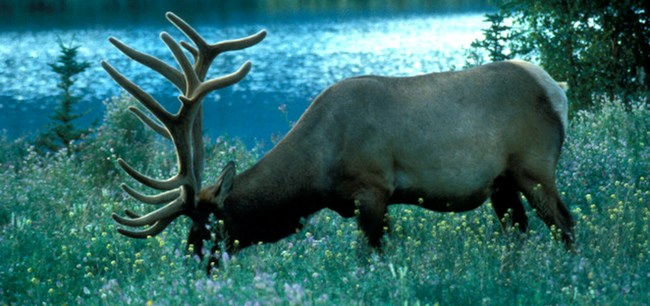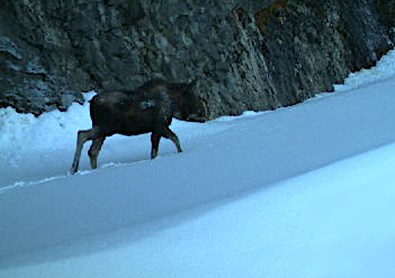|
As one might expect, hoofed mammals are grouped together because they have hooves, unlike all other mammal species. Elk, deer, and mountain goats all have two-toed or cloven hooves. Hoofed mammals are part of a group sometimes know as "megaherbivores" because they tend to be the largest terrestrial herbivores. Deer - family Cervidae
NPS / Filo Merid Black-tailed DeerOdocileus hemionus columbianus Black-tailed deer are a sub-species of mule deer (Odeocileus hemionus hemionus) found west of the Cascade Mountains. Black-tailed deer have all black tails, while mule deer have white tails with black tips. Otherwise black-tailed deer and mule deer are very similar, both in appearance and behavior. Black-tailed deer, like mule deer, have large, fuzzy, mule-like ears, red-brown coats, and white rumps. These deer are found widely in the park's forested regions. In summer, bucks will move to higher elevations while does and fawns stay at lower regions. Deer are most active at dawn and dusk and they eat a variety of grasses and vegetation. In winter their diet shifts to include more twigs and woody vegetation. 
NPS/Teresa Stoker ElkCervus canadensis Elk, also known as Wapiti, are some of the largest mammals found in the park. They can weigh between 400-1,100 pounds. Elk have gold-brown coats with darker-colored legs and necks, and large yellowish-white rump patches. Winter coats can be a darker grey-brown color. Bull elk have shaggy dark brown throat manes and begin growing antlers in their second year. Elk are found throughout the park, moving from lower elevations in fall to higher elevations in spring. They eat primarily grasses in summer, shifting to woody plants and fallen leaves in fall and winter. Additional Research: Schullery, Paul. A History of Native Elk in Mount Rainier National Park. 2004 Web Ed. 
NPS Photo MooseMoose (Alces americanus) are not historically found in Mount Rainier National Park, but the first recorded moose sighting from within Mount Rainier National Park and southwestern Washington was recorded in December 2022! Goats - family Bovidae
NPS Photo / Filo Merid Mountain GoatOreamnos americanus In contrast to their shaggy all-white coats, mountain goats have black lips, eyes, noses, and hooves. A dense warm undercoat allows them to live comfortably at high elevations even during winter. Their hooves have a hard outer ring with a spongy center that helps them "stick" to rocks. Mountain goats are nimble climbers, easily traversing steep rock slopes and cliffs. Both males and females have slim black horns. In males, the horns thicken and curl backwards as the goat ages. Mountain goats will range between subalpine and alpine regions in the park. They eat mosses, lichens, shrubs, some grasses and other vegetation. Return to Mammal Guide |
Last updated: September 9, 2025
